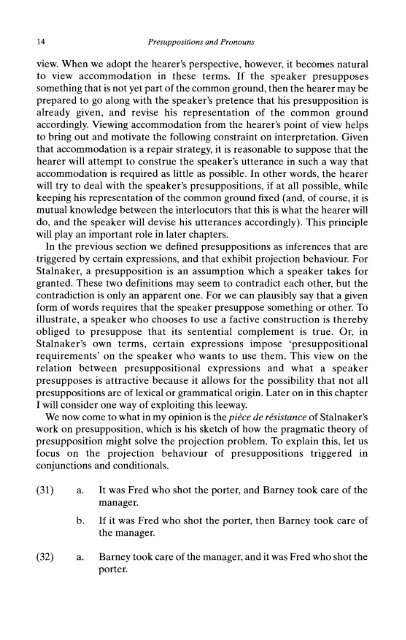Presuppositions and Pronouns - Nijmegen Centre for Semantics
Presuppositions and Pronouns - Nijmegen Centre for Semantics
Presuppositions and Pronouns - Nijmegen Centre for Semantics
You also want an ePaper? Increase the reach of your titles
YUMPU automatically turns print PDFs into web optimized ePapers that Google loves.
14 <strong>Presuppositions</strong> <strong>and</strong> <strong>Pronouns</strong><br />
view. When we adopt the hearer's perspective, however, it becomes natural<br />
to view accommodation in these terms. If the speaker presupposes<br />
something that is not yet part of the common ground, then the hearer may be<br />
prepared to go along with the speaker's pretence that his presupposition is<br />
already given, <strong>and</strong> revise his representation of the common ground<br />
accordingly. Viewing accommodation from the hearer's point of view helps<br />
to bring out <strong>and</strong> motivate the following constraint on interpretation. Given<br />
that accommodation is a repair strategy, it is reasonable to suppose that the<br />
hearer will attempt to construe the speaker's utterance in such a way that<br />
accommodation is required as little as possible. In other words, the hearer<br />
will try to deal with the speaker's presuppositions, if at all possible, while<br />
keeping his representation of the common ground fixed (<strong>and</strong>, of course, it is<br />
mutual knowledge between the interlocutors that this is what the hearer will<br />
do, <strong>and</strong> the speaker will devise his utterances accordingly). This principle<br />
will play an important role in later chapters.<br />
In the previous section we defined presuppositions as inferences that are<br />
triggered by certain expressions, <strong>and</strong> that exhibit projection behaviour. For<br />
Stalnaker, a presupposition is an assumption which a speaker takes <strong>for</strong><br />
granted. These two definitions may seem to contradict each other, but the<br />
contradiction is only an apparent one. For we can plausibly say that a given<br />
<strong>for</strong>m of words requires that the speaker presuppose something or other. To<br />
illustrate, a speaker who chooses to use a factive construction is thereby<br />
obliged to presuppose that its sentential complement is true. Or, in<br />
Stalnaker's own terms, certain expressions impose 'presuppositional<br />
requirements' on the speaker who wants to use them. This view on the<br />
relation between presuppositional expressions <strong>and</strong> what a speaker<br />
presupposes is attractive because it allows <strong>for</strong> the possibility that not all<br />
presuppositions are of lexical or grammatical origin. Later on in this chapter<br />
I will consider one way of exploiting this leeway.<br />
We now come to what in my opinion is the piece de resistance of Stalnaker's<br />
work on presupposition, which is his sketch of how the pragmatic theory of<br />
presupposition might solve the projection problem. To explain this, let us<br />
focus on the projection behaviour of presuppositions triggered in<br />
conjunctions <strong>and</strong> conditionals.<br />
(31) a. It was Fred who shot the porter, <strong>and</strong> Barney took care of the<br />
manager.<br />
b. If it was Fred who shot the porter, then Barney took care of<br />
the manager.<br />
(32) a. Barney took care of the manager, <strong>and</strong> it was Fred who shot the<br />
porter.














